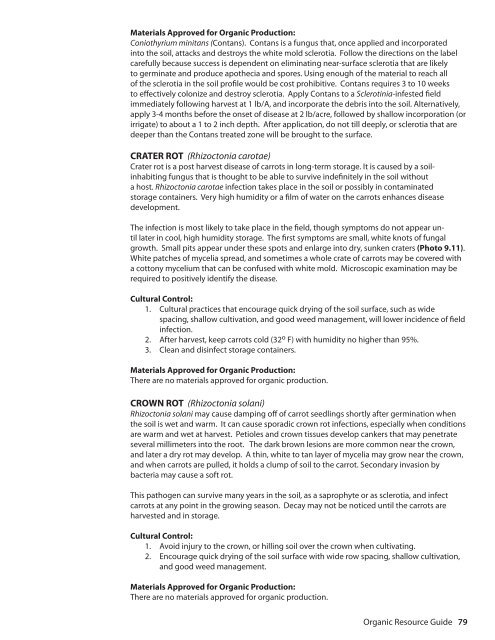Resource Guide for Organic Insect and Disease ... - Cornell University
Resource Guide for Organic Insect and Disease ... - Cornell University
Resource Guide for Organic Insect and Disease ... - Cornell University
Create successful ePaper yourself
Turn your PDF publications into a flip-book with our unique Google optimized e-Paper software.
Materials Approved <strong>for</strong> <strong>Organic</strong> Production:<br />
Coniothyrium minitans (Contans). Contans is a fungus that, once applied <strong>and</strong> incorporated<br />
into the soil, attacks <strong>and</strong> destroys the white mold sclerotia. Follow the directions on the label<br />
carefully because success is dependent on eliminating near-surface sclerotia that are likely<br />
to germinate <strong>and</strong> produce apothecia <strong>and</strong> spores. Using enough of the material to reach all<br />
of the sclerotia in the soil profile would be cost prohibitive. Contans requires 3 to 10 weeks<br />
to effectively colonize <strong>and</strong> destroy sclerotia. Apply Contans to a Sclerotinia-infested field<br />
immediately following harvest at 1 lb/A, <strong>and</strong> incorporate the debris into the soil. Alternatively,<br />
apply 3-4 months be<strong>for</strong>e the onset of disease at 2 lb/acre, followed by shallow incorporation (or<br />
irrigate) to about a 1 to 2 inch depth. After application, do not till deeply, or sclerotia that are<br />
deeper than the Contans treated zone will be brought to the surface.<br />
CRATER ROT (Rhizoctonia carotae)<br />
Crater rot is a post harvest disease of carrots in long-term storage. It is caused by a soilinhabiting<br />
fungus that is thought to be able to survive indefinitely in the soil without<br />
a host. Rhizoctonia carotae infection takes place in the soil or possibly in contaminated<br />
storage containers. Very high humidity or a film of water on the carrots enhances disease<br />
development.<br />
The infection is most likely to take place in the field, though symptoms do not appear until<br />
later in cool, high humidity storage. The first symptoms are small, white knots of fungal<br />
growth. Small pits appear under these spots <strong>and</strong> enlarge into dry, sunken craters (Photo 9.11).<br />
White patches of mycelia spread, <strong>and</strong> sometimes a whole crate of carrots may be covered with<br />
a cottony mycelium that can be confused with white mold. Microscopic examination may be<br />
required to positively identify the disease.<br />
Cultural Control:<br />
1. Cultural practices that encourage quick drying of the soil surface, such as wide<br />
spacing, shallow cultivation, <strong>and</strong> good weed management, will lower incidence of field<br />
infection.<br />
2. After harvest, keep carrots cold (32 o F) with humidity no higher than 95%.<br />
3. Clean <strong>and</strong> disinfect storage containers.<br />
Materials Approved <strong>for</strong> <strong>Organic</strong> Production:<br />
There are no materials approved <strong>for</strong> organic production.<br />
CROWN ROT (Rhizoctonia solani)<br />
Rhizoctonia solani may cause damping off of carrot seedlings shortly after germination when<br />
the soil is wet <strong>and</strong> warm. It can cause sporadic crown rot infections, especially when conditions<br />
are warm <strong>and</strong> wet at harvest. Petioles <strong>and</strong> crown tissues develop cankers that may penetrate<br />
several millimeters into the root. The dark brown lesions are more common near the crown,<br />
<strong>and</strong> later a dry rot may develop. A thin, white to tan layer of mycelia may grow near the crown,<br />
<strong>and</strong> when carrots are pulled, it holds a clump of soil to the carrot. Secondary invasion by<br />
bacteria may cause a soft rot.<br />
This pathogen can survive many years in the soil, as a saprophyte or as sclerotia, <strong>and</strong> infect<br />
carrots at any point in the growing season. Decay may not be noticed until the carrots are<br />
harvested <strong>and</strong> in storage.<br />
Cultural Control:<br />
1. Avoid injury to the crown, or hilling soil over the crown when cultivating.<br />
2. Encourage quick drying of the soil surface with wide row spacing, shallow cultivation,<br />
<strong>and</strong> good weed management.<br />
Materials Approved <strong>for</strong> <strong>Organic</strong> Production:<br />
There are no materials approved <strong>for</strong> organic production.<br />
<strong>Organic</strong> <strong>Resource</strong> <strong>Guide</strong> 79







